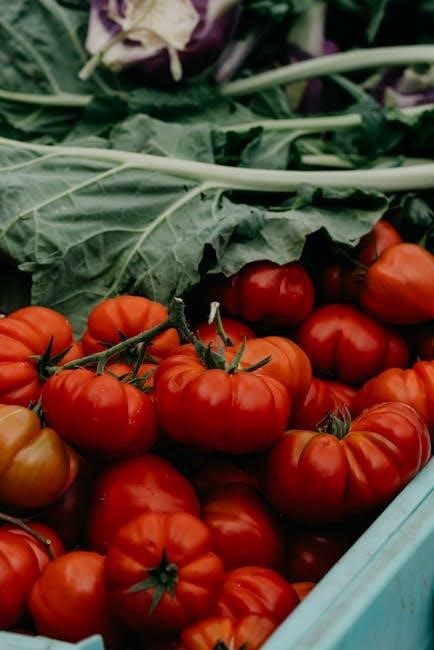The glycemic index (GI) is a vital tool for understanding how fruits affect blood sugar levels. It ranks foods on a scale from 0 to 100, based on their impact on blood glucose. Fruits vary widely in their GI values, making some more suitable for blood sugar management than others. This guide explores the GI of various fruits, helping you make informed choices for a healthier diet.
What is the Glycemic Index (GI)?
The Glycemic Index (GI) is a numerical scale that measures how quickly foods raise blood sugar levels after consumption. It ranks foods on a scale from 0 to 100, with pure glucose set at 100. Foods are tested by measuring the blood sugar response of participants compared to this reference; High GI foods, such as white bread and sweets, cause rapid spikes in blood sugar, while low GI foods, like whole grains and vegetables, result in slower, more gradual increases.
The GI is particularly important for individuals managing diabetes or prediabetes, as it helps guide food choices to maintain stable blood sugar levels. However, its utility extends to anyone interested in understanding how different foods affect their blood glucose. The GI is measured by averaging blood sugar responses from a group of people after consuming a specific food. While similar foods may have varying GI values, the index provides a standardized way to compare their impact on blood sugar.
It’s important to note that while the GI is a valuable tool, it should be considered alongside other nutritional factors like calorie content and overall dietary needs. Additionally, individual responses to foods can vary, and factors like preparation and ripeness may influence a food’s GI. Thus, the GI is best used as one component of a comprehensive approach to diet and health.
Importance of GI for Blood Sugar Management
The Glycemic Index (GI) plays a crucial role in managing blood sugar levels, particularly for individuals with diabetes or those at risk of developing insulin resistance. By understanding the GI of foods, especially fruits, individuals can make informed dietary choices to maintain stable blood glucose levels. High GI fruits cause rapid spikes in blood sugar, which can lead to energy crashes and increased insulin demands, potentially worsening diabetes symptoms; Conversely, low GI fruits promote gradual glucose absorption, helping to prevent drastic fluctuations in blood sugar.
For individuals with diabetes, incorporating low GI fruits into their diet can enhance blood sugar control and reduce the risk of complications. The GI also aids in portion control and meal planning, allowing individuals to balance their carbohydrate intake effectively. Additionally, pairing low GI fruits with proteins or fats can further moderate blood sugar responses, supporting overall metabolic health. By prioritizing low GI options, individuals can enjoy fruits while maintaining better glycemic control and promoting long-term health outcomes.

Low Glycemic Index Fruits
Low glycemic index (GI) fruits are ideal for maintaining stable blood sugar levels and promoting healthy metabolism. These fruits, such as cherries, apples, and pears, have a GI of 55 or below, making them excellent choices for blood sugar control and overall well-being.
Fruits with GI 55 or Below

Fruits with a glycemic index (GI) of 55 or below are considered low GI and are excellent for maintaining stable blood sugar levels. Examples include cherries (GI 32), apples (GI 38), and pears (GI 35), which are rich in fiber and antioxidants. These fruits digest slowly, preventing rapid spikes in blood glucose. Other low GI fruits like plums (GI 39) and grapefruit (GI 25) are also ideal for those managing diabetes or prediabetes. Their natural sugars are released gradually, providing sustained energy and supporting overall metabolic health. Incorporating these fruits into meals or snacks can help regulate blood sugar responses and promote a balanced diet. They are also low in calories and high in essential nutrients, making them a nutritious choice for everyone. By focusing on low GI fruits, individuals can enjoy the benefits of fruit while maintaining better blood sugar control and improving their overall well-being.
Best Low GI Fruits for Diabetes and Blood Sugar Control
Certain low GI fruits are particularly beneficial for managing diabetes and blood sugar levels. Apples, with a GI of 38, and pears at GI 35, are excellent choices due to their high fiber content, which slows sugar absorption. Berries like strawberries (GI 32) and blueberries (GI 40) are also ideal, offering antioxidants and minimal impact on blood glucose. Citrus fruits such as oranges (GI 40) and grapefruit (GI 25) are similarly advantageous, providing sustained energy release. These fruits not only help regulate blood sugar but also contribute to a balanced diet rich in essential vitamins and minerals. For individuals with diabetes, incorporating these low GI fruits into meals or snacks can enhance blood sugar control and overall health. Their natural sugars are digested slowly, preventing sharp spikes and promoting stable energy levels throughout the day. By selecting these fruits, individuals can enjoy their nutritional benefits while maintaining better glycemic management.
High Glycemic Index Fruits

High glycemic index fruits, such as mangoes (GI 70) and pineapples (GI 72), cause rapid blood sugar spikes due to their higher natural sugar content. These fruits should be consumed in moderation, especially by those managing blood sugar levels.
Fruits with GI 70 or Above
Certain fruits have a glycemic index (GI) of 70 or higher, indicating they can cause significant blood sugar spikes. Examples include mangoes (GI 70), pineapples (GI 72), and watermelon (GI 75). These fruits contain higher amounts of natural sugars, which are quickly absorbed into the bloodstream. While they can still be part of a healthy diet, moderation is key, especially for individuals managing diabetes or prediabetes. Pairing these fruits with protein, healthy fats, or fiber-rich foods can help slow digestion and reduce their impact on blood sugar levels. Understanding the GI of fruits is essential for making informed choices to maintain stable glucose levels and overall health.
How High GI Fruits Affect Blood Sugar Levels
High GI fruits, with a glycemic index of 70 or above, cause rapid increases in blood sugar levels. This is because their natural sugars are quickly digested and absorbed into the bloodstream. For individuals with diabetes or those managing blood sugar, consuming these fruits without balance can lead to glucose spikes, potentially causing energy crashes and increased hunger. Over time, frequent consumption may contribute to insulin resistance, a precursor to type 2 diabetes. However, by pairing high GI fruits with protein, healthy fats, or fiber-rich foods, their impact can be mitigated. Portion control is also crucial to avoid excessive carbohydrate intake. Understanding how these fruits affect blood sugar helps in making smarter dietary choices for better glucose regulation and overall health.

Glycemic Load and Fruit Portion Control
Glycemic load (GL) measures the actual impact of a fruit’s carbohydrates on blood sugar, considering serving size. Portion control is essential, as even low GI fruits can affect blood sugar if eaten in excess.
Difference Between Glycemic Index and Glycemic Load

The glycemic index (GI) and glycemic load (GL) are related but distinct concepts. The GI is a scale (0-100) that ranks foods based on how quickly they raise blood sugar levels after consumption. It focuses solely on the type of carbohydrates in a food. On the other hand, the GL considers both the GI and the amount of carbohydrates in a serving, providing a more practical measure of a food’s impact on blood sugar. For example, a food with a low GI may still have a high GL if a large portion is consumed. Understanding both GI and GL helps in making informed dietary choices, especially for managing blood sugar levels effectively.

Portion Size and Carbohydrate Content in Fruits
Portion size and carbohydrate content play a crucial role in how fruits affect blood sugar levels. Even fruits with a low glycemic index (GI) can impact blood sugar if consumed in large quantities. For example, while an apple has a GI of 38, eating multiple servings can significantly increase carbohydrate intake. The glycemic load (GL) takes both GI and portion size into account, offering a clearer picture of a fruit’s blood sugar impact. Generally, a serving size of fruit provides about 15 grams of carbohydrates, but this varies. Berries, citrus fruits, and apples tend to have lower carbohydrate content, while tropical fruits like mangoes and bananas are higher. Being mindful of portion sizes ensures that fruits can be enjoyed as part of a balanced diet, helping to maintain healthy blood sugar levels.
